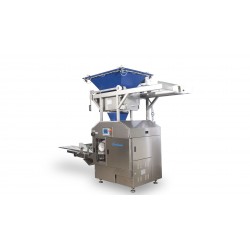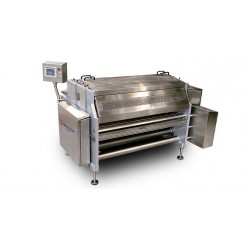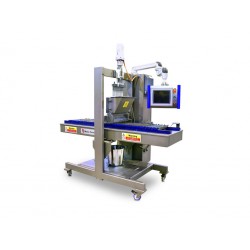- New
Forming and molding equipment for the food industry consists of mechanical and automated devices that allow you to obtain a product of a certain shape and size from an input that possesses plasticity. Forming and molding is the process of giving food products the desired shape, size, and characteristics, and it may also include drawing a pattern on the surface of a semi-finished product.
What this equipment provides
Forming and molding equipment in the food industry is represented by all kinds of units that can synchronously measure out and shape the raw product mass by dividing the whole mass into portions or, conversely, by joining individual components.
These units differ in the set of functions that they provide.
Methods and types of ingredient forming and molding:
- casting and jigging;
- stamping;
- pressing;
- extrusion;
- forming inside a shell;
- unreeling and sizing;
- rounding, curling, and spinning;
- elongating;
- cutting.
The specific features of the forming and molding process are what determine the right choice of equipment for your production.
Synonyms: molding machine, forming machine, jigging machine, jigging plant, confectionary jigging plant, food forming line, extruder, rotary former, food extruder, extrusion machine, food casting machine, cutting forming machine, doughsheeter, doughsheeting machine, dough depositor, meat-patty molding machine.
The most common methods for giving a product a certain shape.
When products go through forming and molding machines, a portion of the raw input, measured out by mass or volume, acquires a certain shape.
Extrusion
Food extrusion is the process by which soft mixed ingredients are forcibly pushed through shaped holes in a perforated die at a given speed, in order to give the product mass a certain shape.
Equipment models differ based on the type of extrusion they provide:
In the cold method under pressure, the raw inputs are slowly mixed and then molded according to the specified parameters. The presence of a cooling system prevents the overheating that could otherwise occur due to mechanical friction. This method is mostly used for producing traditional types of pasta. It is also widely used for molding confectionery masses into entwined shapes when producing various types of sweets.
In the process of warm extrusion, the influence of temperature is added to the mechanized mixing – the raw inputs are heated during processing and thus take on additional volume.
Another extrusion method, hot extrusion, involves the effects of high speed and increased pressure, so that mechanical energy is converted into heat and this causes biochemical changes in the products.
This technology is used to produce a wide range of food products: filled confectionery products, grain-based products, snacks, chips, and corn puffs and corn flakes.
More information on equipment intended for warm and hot extrusion can be found here.
Casting
Casting refers to filling a mold with a dosed amount of a fluid product.
The liquid or viscous mass solidifies in the mold and takes on the required shape. In this way, for example, chocolate bars are made from liquid raw materials.
Jigging
This method is used for shaping piecewise products. Outputs in a viscous state are deposited onto a conveyor belt through nozzles of the required type.
Thus, ready-made cakes and all kinds of pastries can be decorated with curly designs.
Stamping
During the process of stamping, the initial mass is compressed into a limited volume; the amount of pressure is kept under constant control. It is important that the original state of the product be preserved.
Stamping is done using special drums or stamps engraved with pictures or abstract designs.
This method is used in the making of caramels, pasta, and other food products embossed with a design.
Squeezing
In a continuous or cyclic mode, a softened raw input is squeezed out by means of high-strength plates.
The shape and other properties of the holes determine the shape that the finished products, such as pasta or candies, will have.
Cutting
This process consists in giving products a certain shape and other properties. It is important that each large piece be divided into smaller parts without a significant amount of wastage.
The main indicators that determine the quality of the product after cutting are the product surface as well as how uniform the shape, size, and weight are of each piece that is obtained.
This technology is actively used in the production of flour-based foodstuffs such as noodles, as well as for semi-finished products made with meat and fish.
Compressing into a specified volume
Loose or powdery ingredients are compressed into a specified volume by means of compression elements that can be of various dimensions and configurations.
In this way, products like spices are produced.
Rolling
Rolling is the production of pieces in layers as the ingredients, e.g. chewing gum, move through the machine between moving rolls.
Spinning
Spinning allows you to give a given shape to viscous semi-finished products. This shape can be a cylinder, a cone, or a ball. Products take on the desired shape as a result of rotation and regular friction against surfaces.
This method is particularly relevant for candies and flour-based products.
|
Products obtained by forming and molding |
|
|
Mode of action |
Products |
|
Cold extrusion |
Flour-based products, pasta, noodles, processed cheese, sweets, minced-meat products, extrusion-modified flour |
|
Casting |
Chocolate products with filling inside, candies from marmalade, dairy, jelly, fruit, fondant or liqueurs |
|
Jigging |
Marshmallow, meringue, items from flavored and gingerbread dough, sweets, chocolate, two-color cookies |
|
Stamping |
Crackers, crispbread, round, rectangular or oval cookies and sugar cookies, small hard candy pieces and caramels, shaped lollipops |
|
Squeezing |
Pasta, juices, liqueurs, essence |
|
Cutting |
Confectionery, sweets, waffles, pastries with filling inside, cookies, marshmallows, marmalade, halva, fudge |
|
Compressing into a specified volume |
Tea, coffee, dry concentrate, refined sugar |
|
Rolling |
Bakery products, nut-brittle candies |
|
Spinning |
Lollipops, caramels, baked goods |
Types of forming and molding equipment:
The type of equipment to use for forming and molding food products depends on the properties of the food mass that is to be processed, the required shape of the finished product, and the particular forming and molding process that is used.
Forming and molding equipment is categorized according to a number of features:
- the type of force pump;
- how the force pump operates;
- how the formed product moves;
- the performance of the force pump;
- the amount of force pumps in the plant;
- how the formed product is divided up;
- the presence or absence of forced feeding.
The type of force pump used is a defining feature of forming and molding equipment.
The following types of force pump are most commonly used in food forming and molding machines:
- screw-based: single-screw and multi-screw, meshing and non-meshing;
- piston-based: single-pistons and multi-piston;
- rolling-based: dual-roll and multi-roll;
- disc-based,
- gear-based.
- laminar,
- combined.
The most common type of force pump used in the food industry are screw-based machines.
Among their major advantages is their ability to:
- continuously feed the raw inputs;
- create high pressure, for example, in screw-based pasta presses;
- ensure plasticization and temperature control of the material as it passes along the length of the screw.
Screw-driven forming machines can be divided into single-screw and multi-screw types. The screws can also be intermeshing.
Piston-based force pumps are used in casting and jigging of fluid food masses, separating bulk masses into tablets, and stamping high-viscosity media.
Types of forming and molding equipment
Rotary machines
Enterprises that produce confectionery products from dough (for example, sugar cookies of various shapes) use rotary machines in their process.
Elements of the plant:
- hopper for loading the raw inputs;
- a forming drum or rotor;
- a blade for cutting excess dough;
- a conveyor belt.
The prepared ingredient mass is loaded into the hopper. As the machine is running, a mechanism pushes the ingredient mass into the cavity of the rotor, which can optionally imprint any pattern on the product.
After the excess is trimmed, the mass – which is in a state of plasticity – is laid out on a conveyor belt and sent to the oven.
Some models are used for the production of candies.
Food extruders
Devices that work by means of extrusion allow you to produce full-sized products from various materials that are loose or in a state of plasticity, and to form both moist or dry products, from pasta to crab and fish sticks.
The main advantage of extrusion machines is that the finished products are discharged continuously, and they are then cut to the necessary dimensions.
Extrusion machines differ in the operating body, but there are a number of features that they all share in common.
Common to all extruders, regardless of the particular design, are:
- funnels for the raw inputs that ensure that the production process runs continuously – both manually discharged and automated methods are possible;
- a housing with an integrated feed mechanism, such as a screw or piston;
- an electric drive that activates the moving body;
- a heating system in the form of a winding to maintain the desired temperature inside the cylinder;
- sensors for monitoring the main indicators in production: temperature, speed;
- a forming head with an output hole that is round, square, slit-shaped, or of a complex shape, depending on requirements.
After passing through the holes of the die on the extruder, the raw masses will acquire increased strength.
Casting machines
Production lines for confectionery products with various fillings include casting machines to form and mold liquid and semiliquid masses.
The raw input is cast into shapes from sugar mass or starch. Silicone, plastic, or metal molds are also used.
Casting machines consist of the following:
- a conveyor belt;
- a stamping mechanism;
- a jigging device.
Via a funnel, the raw inputs for the candies enter into the dosing mechanism, which then supplies the products to molds.
Jigging machines
This type of equipment is based on a continuous flow. It is used when working with dough-based products, for molding cream candy shells, marshmallows, cookies and gingerbread, as well as certain chocolate products.
Jigging machines consist of the following:
- a hopper for the raw inputs;
- a device for squeezing;
- special nozzles;
- a conveyor belt;
- a cutter for excess parts of the raw inputs.
Jigging machines are classified according to the type of moving body: piston, screw, or shaft.
The action of the working parts can be periodic or injection.
In a jigging machine for confectionery, several different separation methods are provided:
- clipping;
- cutting;
- breaking finished products.
A dough depositor forms gingerbread cookies, and it also allows you to produce two-color cookies with different compositions and fillings.
Presses
Pressing is the mechanical process by which raw inputs are subjected to pressure with the aim of obtaining a mass of a certain kind.
This technology may involve compressing and reducing the amount of liquid within the composition. This method is used for obtaining purees and juices.
Pressing through a specially shaped mold is also possible. This can be a molder with a hydraulic or pneumatic drive.
For example, meatball-molding machines are mechanical and automated. In machines for molding hamburger patties, the thickness of the product at the output can be adjusted, and the throughput depends on the type of machine.
Units for dividing components into layers
Cutting devices work by dividing a whole product into pieces of a given size.
Besides the properties of the raw ingredients, the quality of the final product also depends on the main element used to cut, the ratio of the cutting and moving speeds, as well as the way in which the product is held while it is cut.
Depending on the design, the following can be used:
- cords;
- cutting discs or blades.
Cord-based cutting machines allow you to immediately cut several layers of sweets, as well as split confectionery in bulk form into portions.
Disc-based cutting machines can easily form sheets of halva and other sweets.
Doughsheeters (doughsheeting machines)
For rolling out rough dough when producing dumplings and noodles, doughsheeting machines are used.
These devices allow you to adjust the width of the strip of dough and the thickness of the rolled sheet.
- New
- New
Automatic egg roll machine (ER-24)
- New

 English
English
 Deutsch
Deutsch
 Français
Français
 Español
Español
 Italiano
Italiano
 Português PT
Português PT











